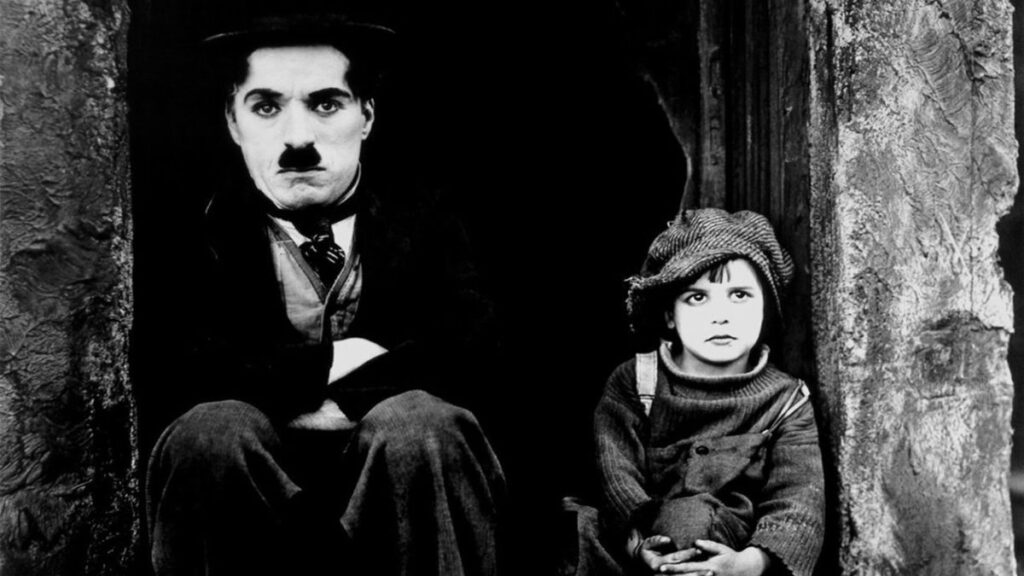A bowler hat, enormous shoes whose toes point in opposite directions from one another, and a comically ill-fitting suit that seems at once baggy and far too small: these are the trademarks of the Tramp, Charlie Chaplin’s most famous character and the ultimate outsider. In this farcical interpretation of a wealthy man’s attire, he mimics the behavior of an ordinary member of society while somehow remaining intrinsically separate. But his most profound moments come when his clownish interactions with the world lead to a genuine human connection, as they do in “The Kid,” Chaplin’s feature length directorial debut, turning 100 this year. Here, the Tramp is tasked with the raising of an abandoned child, and they develop a bond so powerful that we see echoes of it reverberate through cinema, delicately deconstructing traditional notions of fatherhood and, by extension, masculinity. The work that Chaplin does in “The Kid” provides a template for innumerable stories that confront what it means to belong to someone, taking characters who have intentionally detached themselves from a community and reconnecting them with humanity as they are faced with an unconventional version of fatherhood. With its loving depiction of an adoptive father-child dynamic, Chaplin’s century-old film has its fingerprints all over modern entertainment, especially as the familiar storyline had new life breathed into it with the release of “The Mandalorian,” “News of the World,” and “The Midnight Sky.”
“The Kid” is a natural successor to “A Dog’s Life,” a Chaplin comedy from three years earlier which originally posits the question: what would happen if a stray adopted a stray? Our hero is well-defined: he’s a vagabond who lives on the margins of society. His lack of wealth and social cache prevent him from establishing a stable foothold in the world, but they also grant him a measure of independence. He is allowed his comical misadventures because he has no one relying on him as a provider, no real reason to commit to an existence that is more firmly entrenched within society. That is, until the Tramp stumbles upon his ward in a random alley of “The Kid,” a seemingly abandoned baby whom he feels compelled to protect. Unable to foist the child off on any passersby, the Tramp reluctantly takes him home to his barebones hovel, where he quickly rigs up a series of contraptions that will help him better care for his new companion. They spend the next five years together, and his young adopted son (Jackie Coogan), armed with a few carefully deployed rocks, quickly becomes an asset in his window repair scam.
It’s crucial to the impact of the story that the Tramp’s way to earn a living lies outside the law: it further highlights how removed he is from a traditional community and creates a natural conflict within the narrative. The life he can provide for his child is loving, but is that enough? This is the case in “The Mandalorian” as well, where an orphaned bounty hunter raised in an extremely isolating and depersonalizing religion finds himself escorting a Jedi toddler across the galaxy. His life is dangerous, and through each life-or-death scenario he grapples with whether the child is better off safe with the Jedi, or imperiled but with the man it has come to regard as a father figure.

Captain Jefferson Kyle Kidd (Tom Hanks) in “News of the World” is not himself a criminal, but inhabits a tenuous position as a man who travels from town to town throughout the sparsely populated and lawless Old West performing dramatic recitations of the news. He lacks even the connection to civilization that the Tramp’s unassuming shanty provides; Kidd has only a small wagon and a pair of horses to his name, having left his house and business connections behind in San Antonio. Hardly a home for a child, Kidd reasons, even one like Johanna (Helena Zengel), whose life among the Kiowa tribe has made her a particularly suitable candidate for a nomadic existence.
“The Midnight Sky” takes this sense of uninhabitability a step further. Augustine Lofthouse (George Clooney) is a scientist in failing health, whose career and personality have isolated him from not just the concept of a family or a community, but humanity itself. After a cataclysmic event rapidly threatens to extinguish life on Earth, rather than fleeing with his colleagues, he chooses to stay behind at his Arctic research base alone. His plans are diverted when he comes across a young girl, apparently left behind in the rush to evacuate. This child has perhaps drawn the worst straw of all: the Earth itself is hostile to her, and despite Augustine’s best efforts he will likely find himself powerless to offer her protection.
The concept of a vagabond who has purposefully rejected the trappings of a family unit but is then suddenly thrust into the role of the caretaker is an inherently compelling one, and the deep connection they have with one another is no less powerful for its ephemerality. A sense of impermanence is a common thread throughout many of the films that explore this dynamic. As close as ersatz father and child will grow, the specter of their ultimate separation looms large over the proceedings. The Kid may have been raised by Chaplin’s Tramp, but his mother is still alive and mourning his loss, to say nothing of the law enforcement officers who are determined to remove the child from what they consider to be an unsuitable home. Chaplin’s best acting is reserved for their parting, his haunting eyes devastated and helpless as he struggles in vain to break free from the policemen holding him back and rescue the Kid from a paddy wagon. No matter how much he loves his would-be son, the Kid is not the Tramp’s to keep.

Similarly, both the Mandalorian and Captain Kidd’s encounters with their respective children come with a clear expiration date. The Mandalorian is tasked with escorting the Child safely to the Jedi at which time, presumably, their relationship will come to an end. It’s only with a certain reluctance and growing dread that he acknowledges that his time with the Child is perhaps not infinite. Captain Kidd discovers Johanna alone in the forest, a young girl who has been uprooted twice, first from her German immigrant family in a Kiowa raid, and second when her Kiowa family were killed by Union soldiers. She is to be returned to her only remaining relations, an aunt and uncle some several hundred miles away, and Captain Kidd finds himself the only person willing to undertake this journey with her. Their trip through the Texan frontier takes many turns, but it nevertheless has a clear destination in mind. There’s little point in getting attached; Kidd’s role in all of this, as it is with his profession as newsreader, is to serve as an emissary, nothing more. Augustine’s situation is a bit different. He has no real mission to complete other than protecting his young companion, once it becomes clear that no one will be coming back for her. But still, it’s difficult to think of a more definitive ending point to their relationship than a mass extinction event already in progress.
Yet there’s a sense of ambiguity to all these conclusions: hope springs eternal that they won’t be torn apart after all. When the Kid is reunited with his mother, there’s an uncertain space left for the Tramp in their lives. She makes the choice not to shut the door on him, but to invite him in, although it’s unclear what that will mean for the three of them going forward. Captain Kidd seems committed to reuniting Johanna with her extended family, but his growing affection for her creates a lingering question of whether or not he’ll actually turn her over to her stern German relations. And as for the Mandalorian, it’s obvious that he’s struggling with the idea of giving the Child to the Jedi. The bigger question is if he’ll be able to keep the Child with him along the way, with the dying Empire trying to separate them at every turn, and if he does unite the Child with the Jedi, if that actually means their relationship will end. In each case, their relationships are nebulous but potent, their parting no less sorrowful for being seemingly inevitable.

These stories are enduring because they take the ruggedly individualistic male hero who is stubbornly determined to live alone and on his own terms, and create an obstacle in the form of a helpless child. This isn’t his child, and he’s under no obligation or biological imperative to protect it. The Tramp could keep walking down the alley, just as the Mandalorian could hand the Child over to bounty hunters eager to collect it, or Captain Kidd could leave Johanna with her aunt and uncle. Each makes the choice instead to take responsibility for the vulnerable youth, and not only keeps it safe but gently nurtures a deep emotional bond that ties him to the child forever, regardless of where each ultimately ends up. It’s a tremendously optimistic view of humanity, that a reclusive and antisocial person who is perhaps least likely to seek to protect the herd would nonetheless make the choice to care for a small, helpless child for no other reason than instinctual compassion. This raw empathy is why “The Kid” remains Chaplin’s most emotionally complex film, and how his simple story of would-be father and son has maintained its relevance for a century.











